Blog
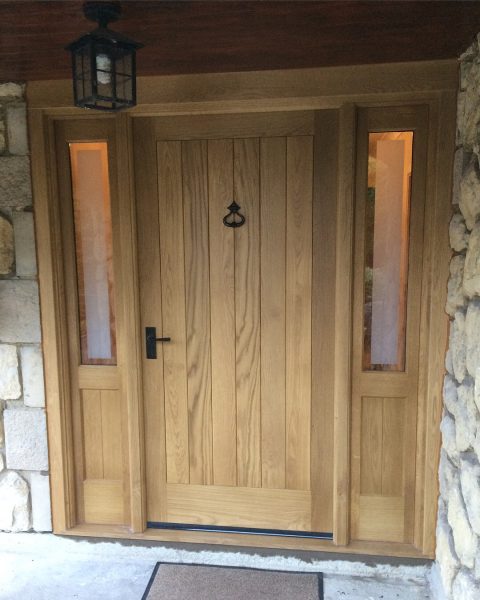
European Oak Front Entrance Frame.
The majority of our internal and external joinery products are manufactured from European Oak.
The popularity of this species of timber never fails to surprise.
Whilst the price between European and American Oak continue to fluctuate, some customers prefer the characteristics of European Oak, which feature a higher content of medullary rays.
As American Oak can not be used externally, this front entrance frame was manufactured from European Oak.
All our European Oak is sourced from the best sustainable suppliers, moisture content is checked upon delivery, and the timber is checked for twist, knots and other defects.
We only manufacture our products from prime grade European Oak, which helps alleviate these issues commonly found within this species of timber.
We was supplied with an image that the customer wanted to replicate, this particular style of front entrance frame is something that we have manufactured numerous times.
The casing features separate rebate lats, the casing legs and head are grooved to house these rebate lats.
These rebate lats can then be moulded, and scribed separately.
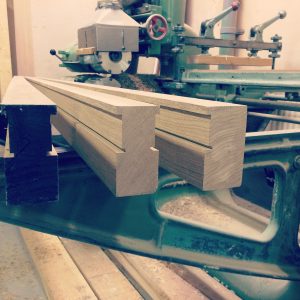
Grooved casing legs.
The thresher is machined and chamfered, this is to lead any excess water that would sit on the sill.
The bottom of the casing legs then have to be cut to this profile.
The door is relatively simple to manufacture, due to the boards sitting flush with the rails, a long and short shoulder is not required, as there is no scribed mould.
The door is manufactured from ex 63mm prime grade European Oak, this is to allow for door boards both internally and externally, and to allow for a 12mm centre framework.
The centre of the rails are again grooved, this will house a 12mm thick framework, which is also manufactured from prime grade European Oak, this forms a barrier between the door boards, which will allow no water to penetrate through the door, it also acts as a fixing aid, the boards will be secretly screwed on the outside face of the door.
The bottom rail of the door is chamfered, this is to lead any water away that would run down the face of the door, between the door boards.
The top rail of the door is also grooved, this is to house the shoulder which will be machined to the top of the door boards.
When this framework and door have been machined to size, the door can then be glued together.
The side wings on this particular front entrance frame are internally beaded, at Hutchinson’s we prefer to internally bead for security reasons, this can also help glaze any elevated external joinery products being glazed from inside the building.
A scribed chamfer is required externally, as the frames are to be internally beaded, this again is to lead the water away from the frame.
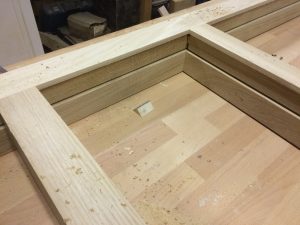
Assembled casing, prior to rebate lat being installed.
The panels within these side wings are manufactured from ex 52mm prime grade European Oak, these panels feature a tenon to the top and bottom, this then sits into a groove that is machined into the rails of the side wing components, this is to form another weather tight seal, and to help alleviate any movement within the side wing panels.
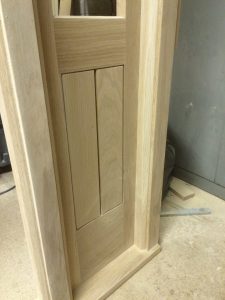
Bottom section of side wing frames.
The side wings can then be glued together, complete with panels.
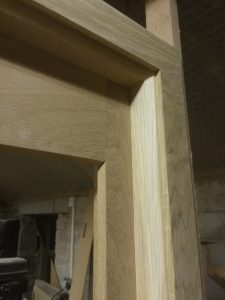
Scribed rebate lat.
All internal components have to be primed with a spirit based primer, left 12 hours to dry, then coated with three coats water borne lacquer prior to being assembled. This is to seal any internal parts of the frame and door that can not be reached when spraying when assembled.
This is a very time consuming part of the process, but an imperative process, which will give protection and longevity to the front entrance frame.
The door boards are tongued and grooved together, these tongues and grooves are also treated before the door is assembled.
The door can then be hinged into the casing, we incorporated 100mm black ball bearing hinges.
The two top hinges are positioned closely together, this helps support the weight of the door.
The lock and thresher can then be fit to both door and casing.
Once all ironmongery is fit and working correctly, the door and frame can be disassembled, and final sanded ready for spray finishing.
The rebate lats which sit against the face of the side wings are acrylic sealed prior to spray finishing, this again creates a weather tight seal, and once sprayed over, hardens but still has flexibility, ideal for changing weather conditions.
Once sprayed the door and frame is left to harden for 48 hours before installation.
If you have a project that requires our skill set, or would like a free quotation or advice, then please get in contact with one of our team.
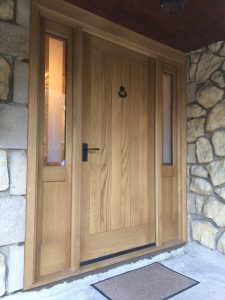
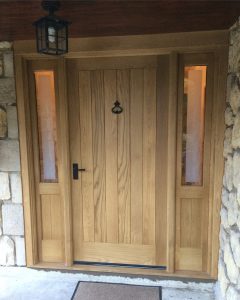
Completed front entrance frame.
